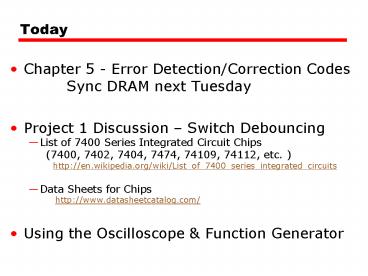Today - PowerPoint PPT Presentation
1 / 23
Title:
Today
Description:
Sync DRAM next Tuesday. Project 1 Discussion Switch Debouncing ... Synchronous DRAM (SDRAM) Access is ... RAM finds data (CPU waits in conventional DRAM) ... – PowerPoint PPT presentation
Number of Views:30
Avg rating:3.0/5.0
Title: Today
1
Today
- Chapter 5 - Error Detection/Correction Codes
- Sync DRAM next Tuesday
- Project 1 Discussion Switch Debouncing
- List of 7400 Series Integrated Circuit Chips
- (7400, 7402, 7404, 7474, 74109, 74112, etc.
) - http//en.wikipedia.org/wiki/List_of_740
0_series_integrated_circuits - Data Sheets for Chips
- http//www.datasheetcatalog.com/
- Using the Oscilloscope Function Generator
2
Chapter 5Internal Memory
Part II Error Detection/Correction Codes
Sync DRAM
3
Error Detection/Correction
- Errors
- Hard Failure
- Permanent defect
- Soft Error
- Random, non-destructive
- No permanent damage to memory
- Coding
- Coding can be used for
- - Error detection
- - Error correcting
- Hamming code will be explored
4
Error Correcting Code Function
5
Hamming Code Example
Visualizing
With even parity
Word
Identifying error
With Error
6
Increased word length for error correcting
7
Hamming Code Design determining K
- To store an M bit word with detection/correction
takes MK bit words - If K 1, we can detect single bit errors but not
correct them - If 2K - 1 gt M K , we can detect and
correct single bit errors, - i.e. detect an error and identify which bit
it is. - Example for M 8
- for K 3 23 1 lt 8 3
- for K 4 24 1 gt 8 4
- Therefore, choose K 4
8
Hamming Code Syndrome
If we compare the read K bits compared with the
write K bits, using an exclusive or function, the
result is called the syndrome. If the syndrome
is all zeros, there were no errors. If there is
a 1 bit somewhere, we know that represents an
error.
9
Hamming Code Syndrome Design Criteria
10
Layout of Data and Check Bits to Achieve Our
Design Criteria
C1 is a parity check on every data bit whose
position is xxx1 C1 D1 exor D2 exor D4
exor D5 exor D7 C2 is a parity check on every
data bit whose position is xx1x C2 D1
exor D3 exor D4 exor D6 exor D7 C4 is a parity
check on every data bit whose position is x1xx
C4 D2 exor D3 exor D4 exor D8 C8 is a parity
check on every data bit whose position is 1xxx
C8 D5 exor D6 exor D7 exor D8
Why? Because we want the syndrome, the Hamming
test word, to yield the address of the error.
11
Example
12
Example
Data stored 00111001 Check bits
Putting it together
13
Example
Word fetched
Check bits
Putting it all together
EXORing 0
1 1 0
0110 6 ? bit position 6 is wrong, i.e. bit D3
is wrong
14
SEC-DEC Example Requires One Extra Check Bit
Single Error Correction, Double Error Detection
Single Error Correction
Word With
Even Parity Word
With Even Parity
With Two Errors
With Errors Identifying
Error SEC Attempt
IS SEC Correct? Extra
Bit Confirms DE
15
We will finish Chapter 5 next Tuesday
16
Improvements in memory
- RAM continually gets denser.
- DRAM Several improvements
- SDRAM synchronous DRAM
- DDR-SDRAM - doubles transfer speed
- RDRAM asynchronous one transfer
- per clock cycle
17
Comparison of improved DRAM
Conventional DRAM 40 to 100 MB/S transfer
rate?
18
Synchronous DRAM (SDRAM)
- Access is synchronized with an external clock
- Address is presented to RAM
- RAM finds data (CPU waits in conventional DRAM)
- Since SDRAM moves data in time with system clock,
CPU knows when data will be ready - CPU does not have to wait, it can do something
else - Burst mode allows SDRAM to set up stream of data
and fire it out in block - DDR-SDRAM sends data twice per clock cycle
(leading trailing edge)
19
SDRAM Read Timing
20
SDRAM
21
DDR SDRAM
- SDRAM can only send data once per clock
- Double-data-rate SDRAM can send data twice per
clock cycle - Rising edge and falling edge
22
RAMBUS
- Adopted by Intel for Pentium Itanium
- Main competitor to SDRAM
- Separate bus (hence the name RAMBUS)
- Bus addresses up to 320 RDRAM chips at 1.6Gbps
- Asynchronous block protocol
- Precise control signal timing
- 480ns access time
- Then 1.6 Gbps
23
RAMBUS Diagram































